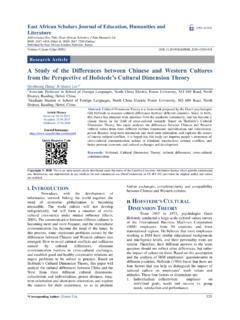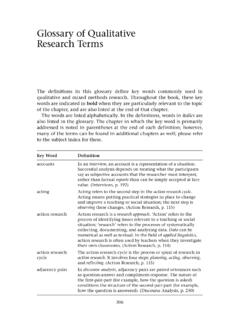Transcription of Application of Reiss’ S Text Typology in Translation- a ...
1 East African Scholars Journal of Education, Humanities and Literature Abbreviated Key Title: East African Scholars J Edu Humanit Lit ISSN: 2617-443X (Print) & ISSN: 2617-7250 (Online) Published By East African Scholars Publisher, Kenya Volume-3 | Issue-2 | Feb-2020 | DOI: *Corresponding Author: Hongping Chen Email: 34 R e s e a r c h A r t i c l e Application of Reiss S Text Typology in Translation- a Case analysis of Franklin D. Roosevelt s fourth inaugural Hongping Chen*1 and Xueyan Zhang1 1 School of Foreign Languages, North China Electric Power University, Baoding, 071000, China Article History Received: Accepted: Published: Journal homepage: Quick Response Code Abstract: Text Typology was proposed in the 1970s, by Katharina Reiss, the pioneer of German School. Built on the concept of equivalence, text Typology views the text, rather than the word or sentence, as the level at which communication is achieved and at which equivalence must be sought.
2 According to it, translation strategies are determined by the text type of source texts , and there is no single absolute translation strategy that can be used in all translation practice. Guided by the theory, this paper will take specific examples to explain briefly how the text Typology guides translation activities. Keywords: Reiss s text Typology , translation methods, translation practice, inaugural address. Copyright @ 2020: This is an open-access article distributed under the terms of the Creative Commons Attribution license which permits unrestricted use, distribution, and reproduction in any medium for non commercial use (NonCommercial, or CC-BY-NC) provided the original author and source are credited. 1. INTRODUCTION OF REISS S TEXT Typology In the 1970s, based on the equivalence theory, Katharina Reiss put forward text Typology in accordance with the categorization of the three functions of language by German linguist Karl B hler.
3 In Karl s work, he divides the language functions into three categories: informative function; expressive function and appellative function. Borrowing from Karl s method of classification, Reiss links the three functions to their corresponding language dimensions and to the text types or communicative situations in which they are used. So she divides texts into three main types and a supplementary one, namely informative texts , expressive texts , operative texts and audio-medial texts . The main characteristics of each text type are summarized by Reiss (1977/1989: 108 9) as follows: 1. Informative text type: Plain communication of facts : information, knowledge, opinions, etc. The language dimension used to transmit the information is logical or referential, the content or topic is the main focus of the communication.
4 2. Expressive text type: Creative composition : the author uses the aesthetic dimension of language. The author or sender is foregrounded, as well as the form of the message. 3. Operative text type: Inducing behavioural responses : the aim of the appellative function is to appeal to or persuade the reader or receiver of the text to act in a certain way, for example to buy a product (if an advert), or to agree to an argument (if a political speech or a barrister s concluding statement). The form of language is dialogic and the focus is appellative. 4. Audio-medial texts , such as films and visual and spoken advertisements which supplement the other three functions with visual images, music, etc. However, text types are categorized according to their main function. For some texts , they don t belong to one single text type, that is, a source text can be an expressive text from one point of view and also an operative text from another.
5 These texts that belong to more than one text types simultaneously are called hybrid types. For example, a biography might be somewhere between the informative and expressive types, because it provides some information about the author for readers while it also conforms to the aesthetic standards as a literature and performs the expressive function of language. In addition, a religious speech may belong to operative type as well as informative Hongping Chen & Xueyan Zhang; East African Scholars J Edu Humanit Lit; Vol-3, Iss-2 (Feb, 2020): 34-37 East African Scholars Publisher, Kenya 35 type, since it gives some information about the religion and meanwhile it achieves the operative function by trying to persuade the audience to do something in a certain way. Therefore, some texts with this kind of hybrid character have not only one language function but several functions mixed together.
6 2. TRANSLATION METHODS SELECTION BASED ON TEXT Typology Although there exist many hybrid types, Reiss (1977/1989: 109) states that the transmission of the predominant function of the ST is the determining factor by which the TT is judged . She suggests specific translation methods according to text type (Reiss 1976: 20). From her, the primary factor that affects the selection of translation methods is text type. She also lists some specific methods for translators to deal with different text types. Firstly, for the text of informative text type, translator needs to transmit all the contents of the ST without redundancy, so that the translation should be explicit and brief. The translation of an economic report, for instance, should focus on the transmission of the content such as specific information and terminology , rather than the literary style used by the author.
7 Secondly, for the text of expressive text type, the method of identifying should be adopted. The translated version should reflect the artistic form and aesthetic features of the ST, in addition ensuring the accuracy of information. So the translator is required to hold the same perspective as the author does and be faithful to the original text. Thirdly, in order to produce an anticipative effect among the TT readers, the text of operative text type should be translated by employing the method of adapting . For example, the translation of an advertisement can make itself more appealing to its receivers through adding some new words or pictures. Finally, as a supplementary text type, audio-medial texts are always in the form of visual pictures or music to supplement the other three functions of written words. Therefore, the method of supplement is proposed by Reiss to solve this kind of text, which means some images, videos and music are added to supplement written words.
8 In a word, Reiss s theory about text type not only provides a way for translators to identify the categories of the ST, but also gives the certain translation methods for each text type, which paves a clearer path for translators to conduct translation activities. 3. A CASE analysis UNDER THE GUIDANCE OF TEXT Typology According to Liu Junping (2009), Reiss believes that the ideal target texts should be those that are equivalent to the source text in terms of conceptual content, linguistic form and communicative function. In this part, three aspects will be presented to analyze the ST: identifying the text type, analyzing the linguistic features and communicative function. Identifying the Text Type According to text Typology , Franklin D. Roosevelt s Fourth Inaugural Address may be somewhere between operative and expressive types.
9 On the one hand, the inaugural address was delivered by the new President Roosevelt, and the audience was the American people, so in fact, there is a communication between the President and the public. And such a speech aims to gain favors and supports from the American people. From this aspect, the inaugural address can infect the audience and make them believe and support the speaker. Thus it can be categorized to the operative text type. On the other hand, as a literary genre, a speech has its own artistic and aesthetic features so that the author or the speaker can express his or her will through the employment of aesthetic dimension of language. In this case, President Roosevelt could show his political aspiration, the determination of leading the Americans to gain freedom and democracy and his good expectation for a bright future through this appealing speech.
10 Therefore, Franklin D. Roosevelt s Fourth Inaugural Address is a hybrid text , called by Reiss, which has the operative and expressive functions at the same time. However, according to Reiss (1989), although different functions may exist simultaneously in one text or at different stages of the text, there always a certain function dominates. Similarly, the writer believes that the inaugural address is dominated by operative function. Example 1 Source: We can and we will achieve such a peace. We shall strive for perfection. We shall not achieve it immediately but we still shall strive. Target: Short sentences give more power. And the aim of communication can be easily achieved by using the pronoun - we , since it may make the speaker become one of the audience, which convinces them that the speaker is speaking for them all.








